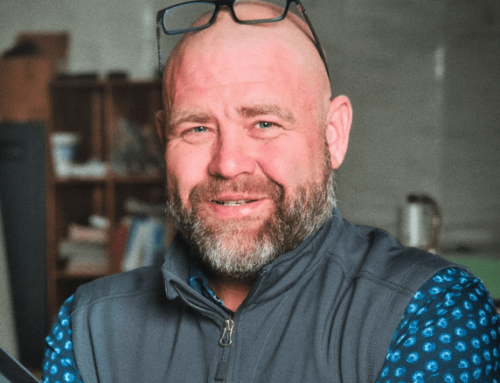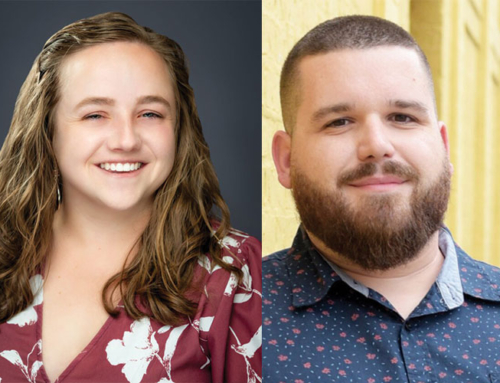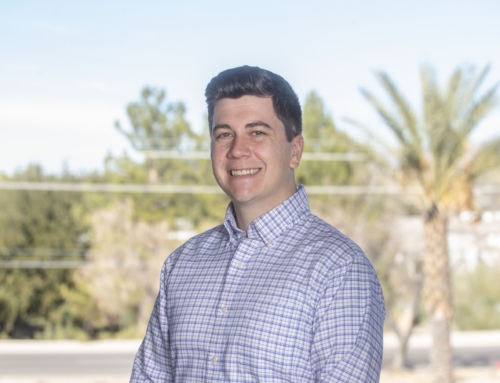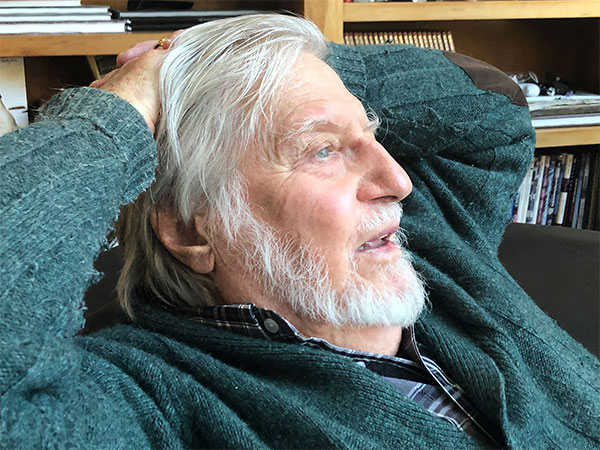
Bob Wick – father, husband, son, brother, artist, environmentalist, friend, newspaper publisher, teacher – died Jan. 13, 2022 after a fight with cancer and subsequent heart attack. Wick was co-owner with his older brother, Walter M. Wick, of Wick Communications, a three-generation multi-media company that has operations in 11 states. Wick and his spouse of 42 years, Estellean Wick, have lived in Sierra Vista, Ariz., since meeting in 1978. He was also a former publisher of the Sierra Vista Herald and the Bisbee Daily Review and was a nationally recognized sculptor in bronze. He was 86.
Wick lived, flourished and shared his humanity in a number of worlds. Foremost was his commitment and love for family and to nature. Wick’s monumental bronze sculptures, which are featured in exhibits throughout the U.S., are distinctive: living trees and plants placed inside the bronzes to reflect the flora and strength of Earth and their connection with mankind.
Wick said that whatever man created — the most typical, shattered rock — “represented more color, form, shape and variety than I could ever imagine.” His art is rich in emotion, thought and purpose. His sculpture is on display at the Wick Poetry Center at Kent State University in Ohio and at several Wick newspapers.
His work with bronze also reflected a shared influence with the newspapers he and his brother owned. Newspapers, whether daily or non-daily, start each issue with a fresh roll of newsprint on the press, or a new digital presence. No two newspaper editions, like sculptures, are alike.
Early life
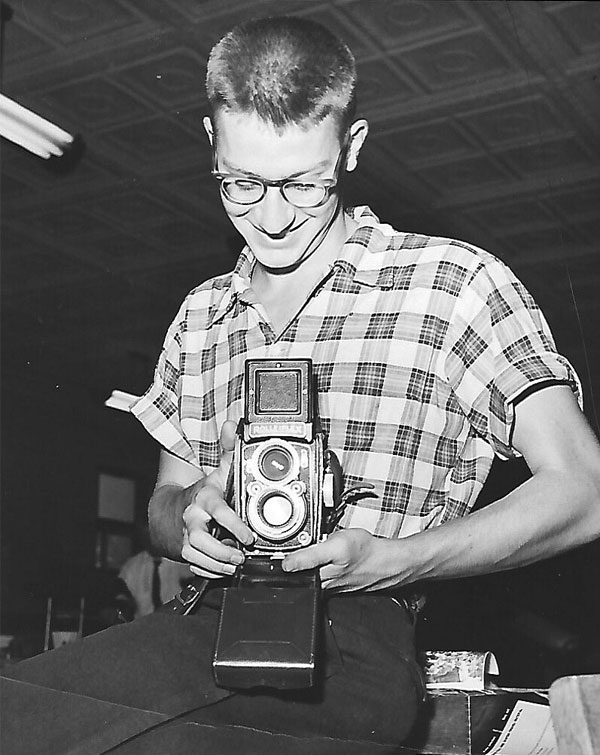
Robert J. Wick was born March 27, 1935 in Niles, Ohio, to Milton and Rosemary (Lomas) Wick. His father and uncle, James, were newspaper publishers and started the family business in 1926. Robert and his older brother Walt, who died in 2016, were exposed early to a community newspaper’s influence. Not only did the Niles Daily Times publish community journalism and news, it took on organized crime in and around the Niles and Cleveland metro area, revealing corruption and reinforcing small businesses that were impacted by mob influence. These early impressions left Wick with a sense of faithfulness and courage that he imbued to later generations of Wick Communications publishers.
Wick graduated in 1957 with a bachelor’s degree in journalism from Kent State University in Ohio. He graduated with a master’s degree in fine art in 1962 from the Cranbrook Academy of Art outside of Detroit. His MFA enabled him to teach in the State University of New York (SUNY) system in Fredonia, NY. In 1958, he and Sidney Barnes married. Their union was blessed with two daughters who survive him: Cornelia Wick Gun of Fort Lauderdale, Fla., and Rosemary (Rosie) Wick of Tucson, Ariz. Ms. Barnes died in 1970. Their son, Stanley Wick, died in 1980. He shared life with Catherine Gates and they, too, were blessed with a child, Nathan Wick, of Ridgway, Colo. Ms. Gates lives in Montrose, Colo.
At an early age, Wick became a lifelong baseball fan, cheering for the hometown Cleveland Indians and the franchise’s best-known pitcher, Bob Feller. Wick was a pitcher himself at Kent State and was asked to try out for the St. Louis Browns of the American League. He even pitched opposite the legendary Satchel Paige in an exhibition game. He often spoke of going to those Cleveland games at the old Municipal Stadium with his family and bragged how they had the best mustard for hot dogs.
Wick was a U.S. Army Reserves veteran.
Moving West
Beginning in 1976, Wick and his three children would spend parts of the year in New York and in Sierra Vista, Ariz., where his brother was the publisher of the Sierra Vista Herald and the Bisbee (Ariz.) Daily Review. They settled in 1980 in Hereford, Ariz., a rural community near Sierra Vista. Wick, as a single parent, was devoted to raising his children while increasingly being involved in the family newspaper business.
In 1978, Wick’s daughter, Rosie, who knew Aida Estellean Conrow through a friend, engineered a “blind date” of sorts. “My dad,” Rosie told Estellean, “wants to ask you for a date.” Estellean, too, was a single parent raising a son, Horace, and worked at Fort Huachuca, a major communications Army post in Sierra Vista. Their kids shared meals and backgammon and soon a romance bloomed. One date included a visit to Wick’s sculpture studio which was then located on the second floor of the Bisbee Daily Review.
As they were getting to know one another, Wick’s first prominent bronze, “Bending Head,” was being completed. Today, it is in the courtyard of the Wick Building in Sierra Vista.
They married in 1980 and celebrated 42 years of love, children, family, travel, business partnerships and political campaigns – all the ups and downs of a long, endearing marriage – which was blessed with a son, Francis Wick, of Sierra Vista. Wick later adopted a son, Horace Wick, and daughter, Destiny Wick. Both survive him.
Wick Communications
Wick and his brother Walt bought out the shares of their uncle, James Wick, in 1965 and were partners with their father, Milton. After Milt’s death in November 1981, they assumed controlling shares and interests. The company was restructured with daily and non-daily newspapers combined into a single entity which today is Wick Communications. With their shared leadership, the company expanded into markets in Oregon, Idaho, North Dakota, South Dakota, California, Alaska, and Colorado. They also grew their existing newspapers in Arizona and Louisiana. The company’s first newspaper outside of Niles, Ohio, was the Daily Herald in Roanoke Rapids, N.C. It was sold in 2017.
All of the legacy and new media had a primary focus: to serve, investigate and advocate for the community’s best interests. The publishers who worked with the two brothers considered them colleagues, rather than corporate figureheads.
Always encouraging, Wick-associated publishers recalled Robert’s warm notes of encouragement, his passion for community newspapering, his quirky – and often applicable – ideas to market these newspapers. He moved with ease between publishers and fine artists and sometimes brought along a publisher to the foundry he used in Athens, Ohio when casting a bronze. He was a great conversationalist; he enthusiastically shared insights and laughter.
Mike Quinn, a Wick-associated publisher in LaPlace, La., and later in a joint ownership (Lake Havasu, Ariz.) recalled, “Bob was a remarkable man with a passion for truth. He looked for it in the way news is covered. He looked for it in art. He asked those who worked in his company to question, question, question and to be unafraid of either the questions themselves or of the answers. He was enigmatic in the best way: a likable, kind man who gave more than he took.”
Will Chapman, a publisher with Wick Communications in New Iberia, La., and company executive for 37 years, noted, “Bob was always interested in what was best for the newspapers his family published and their readers and advertisers, the communities they served and the people who worked at those newspapers. He and his brother Walt had lots of great ideas and gave their publishers the freedom to publish the news and editorial stands which best served local readers. He had a quick smile and was a good listener. Bob was always interesting and fun to be around. I was lucky to know him.”
Both Walt and Bob Wick were inducted into the Arizona Newspaper Association’s Hall of Fame in 2004.
Environmentalist, Astronomer, Philanthropist
In 1984, Wick was part of a group that sought to reduce copper smelter pollution in southeastern Arizona and northern Sonora, Mexico. Groups Against Smelter Pollution (GASP) had a mission of healthy citizenship, preservation of the natural environment and an appreciation of the economic connections between the two countries. There were three smelters in Douglas, Ariz., Cananea, Sonora, and Nacozari, Sonora. Together, the smelters produced the “gray triangle” that blighted the San Pedro Valley and its neighboring communities of Sierra Vista, Bisbee and Douglas. There were many days when the air was stagnant, hazy and residents of those communities couldn’t see the mountains nearby.
The group pressured elected officials from both countries and Phelps-Dodge executives. The push was for P-D to meet the Clean Air Act of 1986. The group painstakingly documented health and environmental effects of the people who lived on both sides of the border. In July 1986, the Environmental Protection Agency refused to renew a Phelps-Dodge exemption to the law and the smelter in Douglas was closed in 1987. The smelters in northern Sonora significantly reduced emissions.
Dick Kamp, founder of Smelter Crisis Education Project (SCEP), was hired to report solely on environmental issues in Arizona, California, Louisiana and Colorado. The pledge of a journalist in this arena was unique to community newspapers.
Conversely, Wick found himself opposing protestors and environmentalists during the early 1990s with the placement of two deep-space telescopes atop Mount Graham in Safford, Ariz. Wick sought sensible and practical applications in order to site the popular observatory.
He was also a member of the University of Arizona’s astronomy board and worked toward solving light pollution so the residents of southern Arizona could enjoy dark skies.
Wick planted more than 1,000 seedling trees over a 10-year period on his land in the Mule Mountains near Bisbee.
Many non-profits have been generously supported by the Robert J Wick Family Foundation:
St Vincent de Paul (food bank), Southern Arizona Children’s Haven, Salvation Army, Amerind Foundation, Inc., NAMI, E-Tech International, Boys and Girls club, to name a few.
The Wick Poetry Center was created in 1984 by Walt and Bob Wick and founding director, Maggie Anderson. The Wick brothers both lost sons tragically, and the center was created to support young poets. The Stanley and Tom Wick Poetry Prize was created as a sustaining award to commemorate their lives. Current director, David Hassler, continues to grow and develop the WPC in educational, therapeutic and collaborative ways. For many summers, he brought students to Bob and Estellean’s home in the Mule Mountains near Bisbee, for poetry workshops and to experience the Sonoran Desert, culminating in community poetry readings, live music dancing and joyful revelry.
Living Sculptures
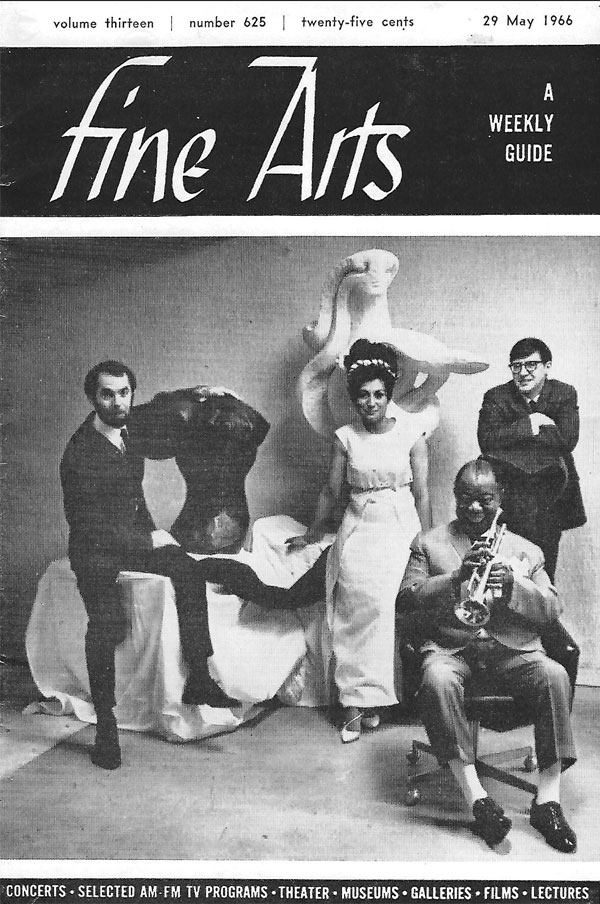
Wick’s sculptures have been exhibited in galleries, botanical gardens and universities throughout the U.S., including the University of Arizona. In 1966, he showed at the Lattavo Gallery in Cleveland. Louis “Satchmo” Armstrong, the legendary trumpeter, previewed Wick’s sculptures saying about his work: “This is Fi-i-i-ne art.” He has also shown with Elaine Horwitch Gallery in Scottsdale, Max Hatchinson in New York and had several shows at the Bienville Gallery in New Orleans.
In addition, he exhibited at the botanical gardens in Tucson, Salt Lake City and Fort Worth, Texas. One spectacular Wick exhibit was in 2008 at the Denver Botanical Gardens. Wick’s 20 bronzes, already alive with plants and trees, were an ideal fit for the popular inner-city setting, more so when much of the art was placed within water features. They were backlit for nightly presentation.
The patinas in Wick’s bronzes are ever-changing with color, natural elements and time. Another signature of his art is the overlying strata. Wick explained the strata represent how man and Earth are of many layers. He drew inspiration from his southern Arizona home and loved the southwest landscape.
“We humans are structured like the Earth,” Wick said. “The Earth has strata of rocks and art. Our strata are genetics and personal environment. The Earth has earthquakes. We have love, birth and death. The Earth has volcanoes. We have pain, violence and creation. It all comes from beneath. The evolution of the Earth is the pulsating heart of mankind.”
Survivors are: wife Estellean Wick, daughter Cornelia Gun (husband Alan Gun), daughter Rosie Wick (husband Sean Fitzpatrick), son Horace (BJ) Wick (partner Natalie Gomez), son Nate Wick (wife Tera Wick), son Francis Wick (wife Mandy Wick), daughter Destiny Wick. Grandchildren Tristyn Wick, Gabriel Gun, Tres Wick, Gia Gun, Sunny Wick, Dorothy Wick, Sebastian Wick and Savannah Wick. And many nieces, nephews, cousins, in-laws and many, many friends.
Wick also had a deep appreciation and love for the many sculpture assistants he had over the years, the most enduring, Mr. Phillip Estrada. He was also grateful for the personal help and friendship of Mrs. Marita Coffman and Mr. Eulalio Leal.
Services will be held at noon Saturday, Jan. 22. Family and friends are kindly asked to RSVP [email protected] for attendance.

